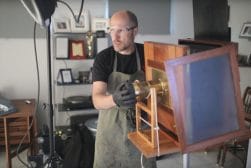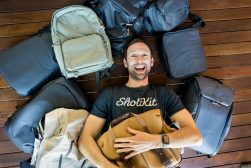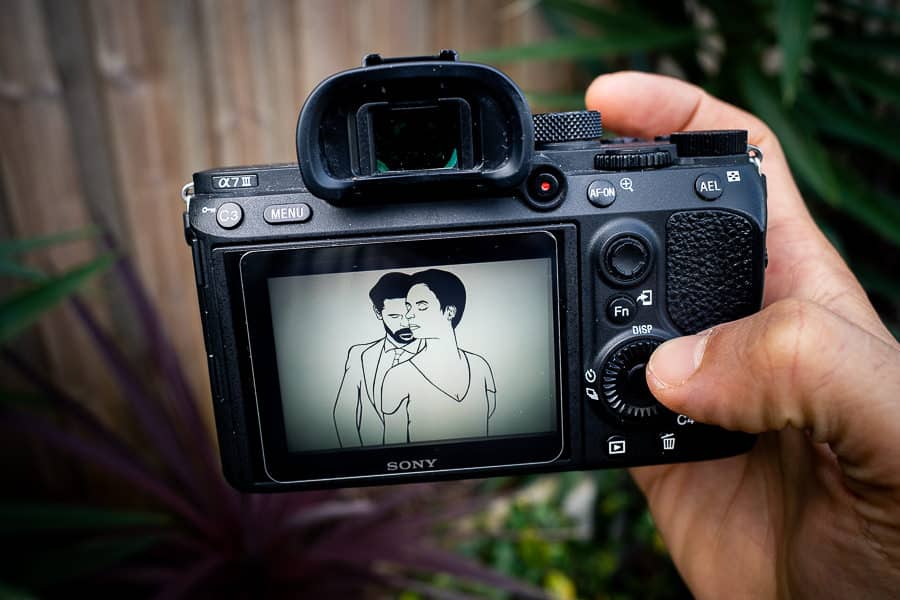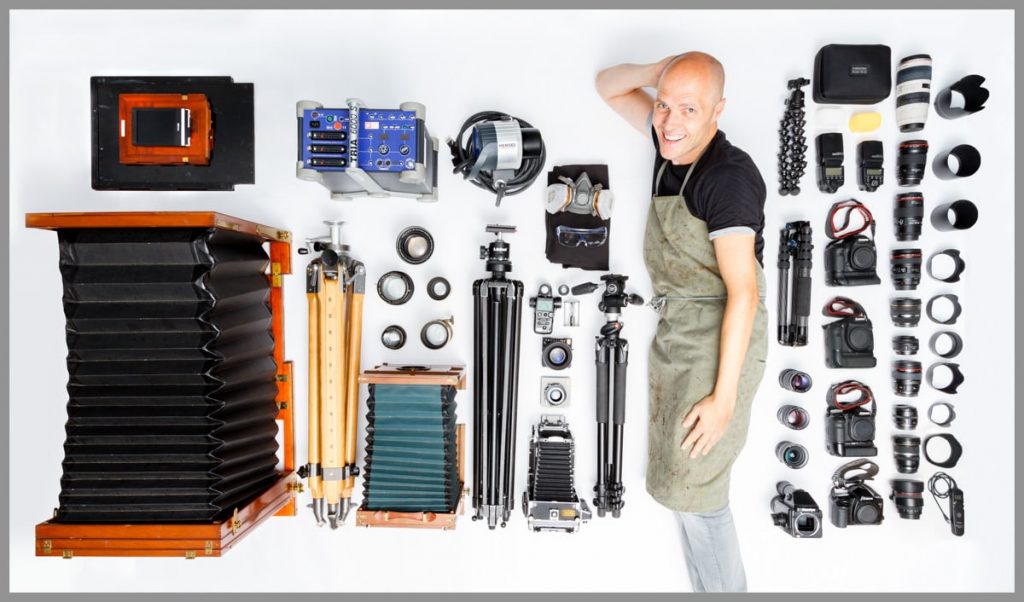
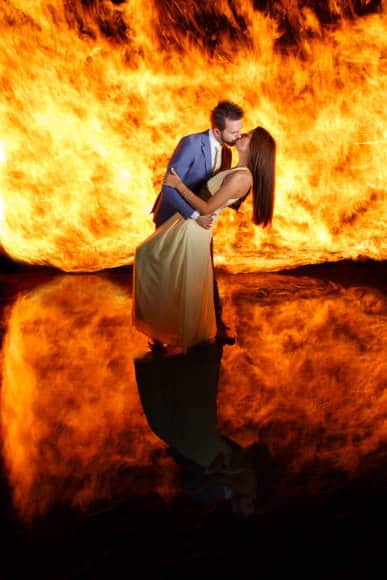
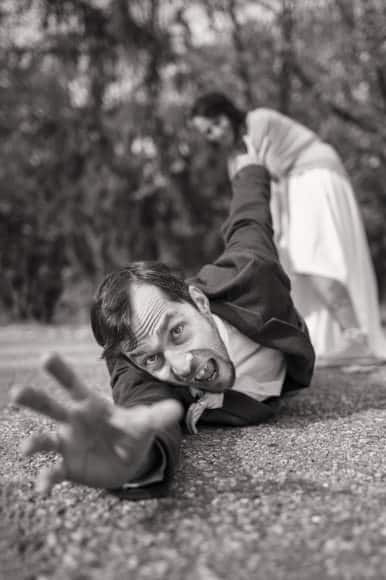
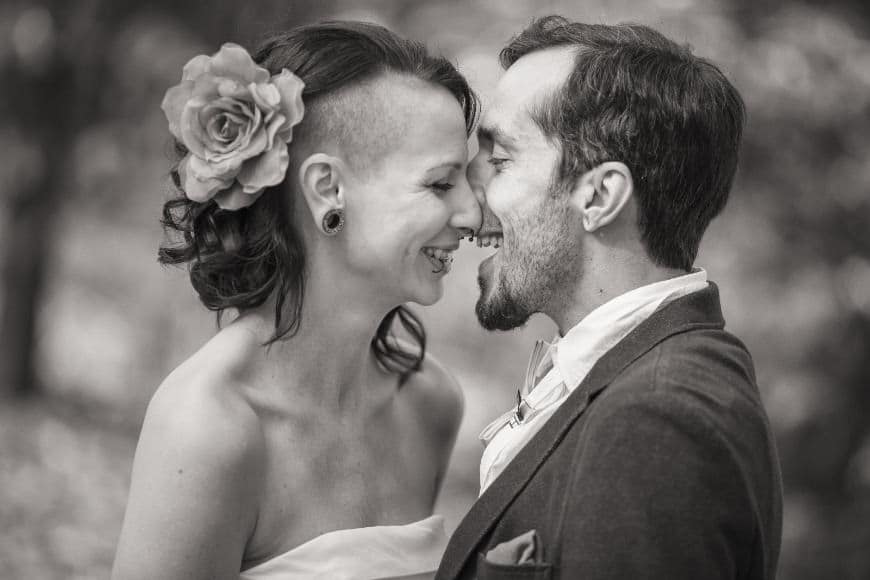
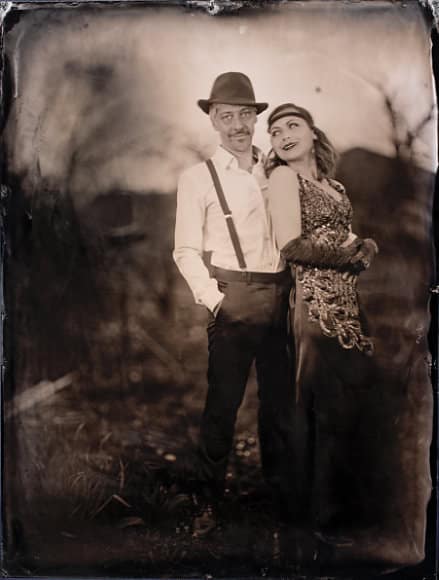

Hi Guys, my name is Markus Hofstätter and I’m a photographer and artist from beautiful Muckendorf and der Donau – Austria (you could translate it as mosquito village at the Danube – yes with have sometimes lot of them).
My work is focused on portraits and weddings, but I also do virtual 360 tours (with also portraits in it) and experimental photography. I love to take the time to create special images with my customers. This includes also a lot of preparation before a wedding. It’s important for me to get to know my customer and their family, so I already have a relationship with them, including their kids, before the wedding. This makes everything easier for everybody and so together we can create memories for a lifetime.
Because I am amazed about human variety I started a worldwide street portrait project. Here I’m using the analog medium (medium and large format cameras) to capture interesting people on the street. Visit here for portraits and stories. This has also affected my portrait photography a lot. It is very similar to the wedding process, I want to know the people I photograph to create images that match their character.
This deceleration led me to the wet plate collodion process (see my guide). Analog photography makes you do more with your hands and pouring collodion on tin types was the next step for me. To take even more time makes a huge change for me and for the customer – photography is a lot about creating memories and the experience.
Besides newspapers and magazines, you can find my photographs in a book. I write also articles for professional German journal and still have my column in a German sports magazine. My wet plate work was presented in several TV documentaries and since 2017 I’ve been giving wet plate workshops in the historical museum Seidel in Krumau (Czech Republic).
My RAW files are processed with Adobe Lightroom and for everything else I switched from Photoshop to Affinity Photo
. Why? Because my CS6 (Windows) license was not working on my new Mac and so I gave Affinity Photo
a shot and never switched back again. It has all the tools I need and there are no monthly fees. Don’t be scared away about the cheap price, this tool has everything you need and is very similar to Photoshop.
My Shotkit photo is a good example about me and my photography.
This is exactly me. With all these different tools I can get creative in many ways.
Until the last TV Interview I thought my way leads more and more into wet plate photography. But then I sat in my studio with the camera pointed to my face and the reporter asked me if I could imagine only doing wet plate photography. I took a very long break, then I started to stutter and finally said no. I just love all facets of photography so much, that I don’t want to exclude any of them.
I love to do portraits and I don’t want to stick to a special medium for that. Doing wet plates needs a lot of knowledge about the chemicals, the materials and you must master the technique of pouring and developing the plates by hand. Every time I put a plate into the fixer it is a magic moment – for me and for the customer. Where else can a customer experience the whole process of creating a one of a kind photograph?
Collodion Wet Plate Gear:
The big wooden ultra large format camera (called Reisekamera – means travel camera, because you can fold it) is for plates up to 12” (30cm) by 16” (40cm) and a real beast if you carry it with the Berlebach Uni 17 wooden tripod (made to handle 20kg of weight). I had to modify this 100-year-old camera and the plate holder a bit to get cleaner wet plates out of it.
To the right is my smaller wooden large format camera (also about 100 years old) for 18 by 23cm (about 8×10”) plates and film which I use with a Linhof Doppelprofil-Stativ tripod. I use the huge Linhof Profi Ballhead on it with an Arca Swiss plate holder.
For 12×16 plates I use mostly the Voigtländer Universal Heliar 360mm f/4.5 (The Harley shoot was done with that one) and the Emil Busch Porträt Aplanat (a Petzval design lens) 280mm f/6 (this one goes up to f/384). For smaller plates, I love the Dallmeyer Petzval 210mm f/3. This extremely fast lens is perfect for wet plates. I have also a smaller 280mm f/4.5 Tessar for traveling. A Kodak Aero Ektar 178mm f/2.5 is also mine, but needs a new lens board (I do all my lens boards by myself).
These old lenses are very important for my photography, because they do not have any special coating against UV light. The collodion wet plate process captures only UV light and this is mostly filtered with newer lenses. The Emil Busch and the Dallmeyer are my favorites here – love the Petzval bokeh. I had to renovate the Emil Busch, it had a bad fungus. But with the right chemicals this was no big deal. It is the sharpest lens I have and really great for portraits.
To get enough light on the plates (we are talking here about ISO 0.5 sensitivity) I can do long exposure or get crystal clear images with my Hensel strobes. The 6000 Watt Hensel Tria 6000S in combination with the EH PRO 6000 strobe head generates enough power to do most portraits with one very bright pop. Mostly I use a Hensel Expert D1000 including the 12” reflector with a grid for rim lightning.
To protect myself against the chemicals I wear a 3M 6002C Mask, 3M 2800 googles, Nitril gloves (acid resistant) and an apron that is from my grandfather—he used it many years ago as shoemaker in the same house I have my studio—this is something special to me. To travel with all my chemicals, I use a light-sealed Explorer 7630 case. It is super rugged and needed if you travel with dangerous chemicals.
To travel with this stuff, my car transforms into a huge camera bag :)
For 4×5 film and plates I use my Linhof Master Technika. A Schneider Kreuznach 240mm f/5.6 Symmar-S and a Schneider Kreuznach Xenar 150mm f/3.5 (That can be left in the camera when folded). I like the 150mm a lot for portraits, even though it is a bit softer than the super sharp 240mm. It has a 50mm view compared to 35mm on 4×5 film and this is closer to what our eyes see than the 240mm lens. Not a typical portrait length on large format – but I like it. The Manfrotto 055XPROB with a Manfrotto three-way head
and the Linhof tripod (if I have to go higher) are the tripods I use with this camera.
For analog (and even for digital) a good light meter is a must, so I got myself a Sekonic DR 758. You can get cheaper ones too, but I love that I can look through the “view finder” and measure directly what I see. With just some more clicks it calculates an average exposure and you can see the dynamic range in stops too. A great tool!
My Mamiya 645E is a great medium format camera for travel – I did lots of street portraits with it.
The Mamiya Sekor C 35mm f/3.5 is a great wide angle lens, but for portraits I love the Mamiya Sekor C 80mm f/1.9. This sharp lens with really shallow depth of field is a great tool for my work. And again, the 80mm on a medium format camera is like a 50mm on 35mm.
Since about 5 months ago I have the Mamiya Sekor C 150mm f/3.5 C and after doing the first test shots with it, this one will be a new lens for wedding portraits in my bag.
I like to use body focus with this camera because I can be much more precise with small body movements.
My main body for digital is the Canon 5D Mark III. I just love the handling and the image quality that comes out of this work horse. The Canon 7D
is often used by the second shooter during a wedding, or for sports events if I need a higher frame rate.
A camera that I still use and have often with me is the Canon 40D. It still works like on the day I bought it and the 10 megapixels are often more than enough. A lot of people will be surprised, that it is pretty clean at higher ISO settings.
Right now I’m looking at the Canon 5D Mark IV, because I want to have a full frame backup camera.
You can also see a Canon EOS 3 camera at the bottom. I still use that one. The eye autofocus works well for me and even made of plastic it’s built to last. I shoot music events and street with this one sometimes, and take it with me on vacation.
The Canon Speedlite 580EX II and the 430 EX II
are my travel strobes. I use them with lots of different modifiers, but the Fstoppers Flashdisc and colored bounce adapters are always in my bag.
For my virtual 360 tours I use a Nodal Ninja RS1 Ring panorama head, a Canon 8-15mm f/4
lens and the Rotator R-D3L
panorama head. I use that one mostly with the Manfrotto tripod to get steady results, but I also use the Sirui T-2205X 5-Section Carbon Fiber Tripod
with the K-20x Ball Head
sometimes for that. I got that and the Joby Gorillapod SLR-Zoom
during a visit in New York at B&H Superstore because I needed something light, and now I use both during traveling a lot.
I bought the Canon EF 8-15mm f/4 L Fisheye USM mainly for the virtual tours, but use it now a lot for group shots and crazy portraits. Its close focus range makes it a great lens for a different view.
At tight events it is super too!
For crop cameras, the Canon EF-S 10-22mm f/3.5-4.5 is a great way to go wide and sharp. I did the Shotkit picture with that one and use it sometimes for group shots in tight locations if I don’t want to use the fisheye.
The Canon EF 24mm f/2.8 (old version) is not the sharpest lens, but it is tiny and mostly in my bag if I shoot street with my EOS 3
. Take a portrait with it and you get a lot of information about the surroundings into the picture.
Events with low light and low space? I use the Canon EF 35mm f/1.4 L for that. Great build quality (full metal) and a fast autofocus is what you get from this one. I often use it for weddings too – the Love on Fire photograph was done with it – it is still sharp at F22.
I own a Nifty Fifty Canon EF 50mm f/1.8 STM, because my Sigma 50mm f/1.4 EX DG HSM
was in repair (I dropped it) for some weeks. I couldn’t get a rental lens from Sigma, so I bought that one. I was surprised how good this cheap lens is. If you want to get a cheap and sharp 50mm with a nice Bokeh – there is nothing wrong to buy that one. I still prefer the faster Sigma, but the Canon is my favorite backup now. The 50mm is my standard Lens for weddings to cover the event or do portraits.
Before I used primes, I used the Canon EF 24-105mm f/4.0 L IS USM very often. Now it’s my standard lens for group shots (I mostly turn the IS off, to get sharper pictures on that one). It’s nice to be able to have the zoom option if your time is limited for a group picture.
I love to shoot portraits with the Canon EF 135mm f/2.0L USM. Sharp, fast autofocus and a very shallow depth of field. For this the lens is quite small and ordinary. If it gets too dark I use the Canon EF 100mm f/2.8L Macro IS USM
. Its image stabilization is amazing and you can easily shoot a portrait at 1/20 and it is sharp too. I bought it mainly for product photos but have it often in my bag for traveling, because of its size. For weddings it is a must for me to do the ring shot.
The Canon EF 70-200 mm f/2.8 L IS II is great for shooting a wedding, because you can be far away from the action and get more natural expressions because people don’t see you and don’t hear the silent mode on the 5D Mark III
. This is also my main lens for corporate portrait sessions. I like the option of the zoom, so I can change the focal length quickly to adjust to different shapes of faces.
For long exposure portraits, I use the Canon Timer TC-80 N3. I bought it mainly for a time lapse project, but now it is always in my bag for all kinds of long exposure stuff.
For a wedding, I have all these lenses and cameras (including the Mamiya) with me in two or three bags. One of them is always the Tamrac Velocity 9. I have used that one since 2010 and like sling style possibilities a lot. For traveling with less equipment, I use a Lowepro Flipside Trek BP250
. You can put your gear directly behind your back and nobody can access it from the front of the bag.








